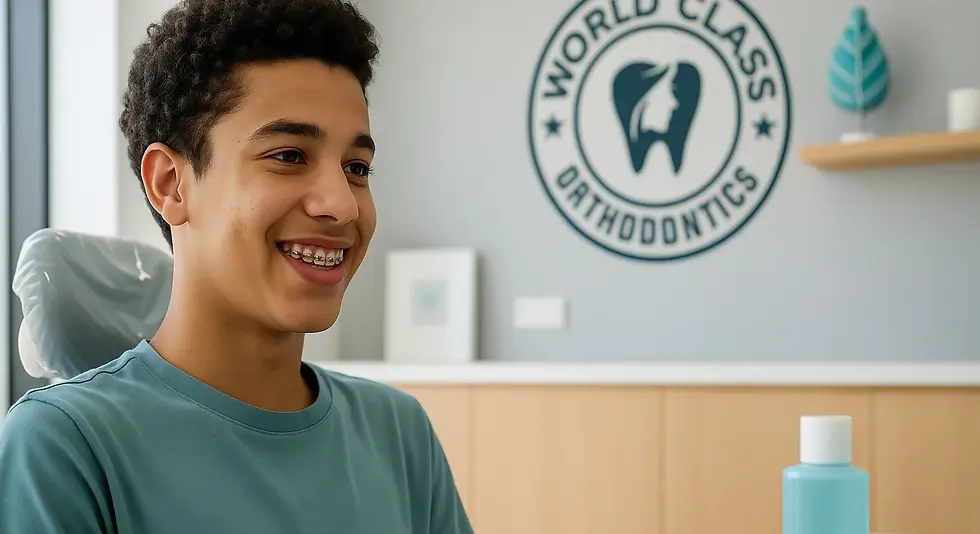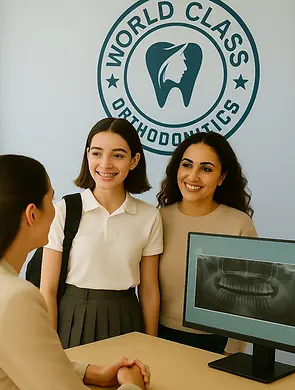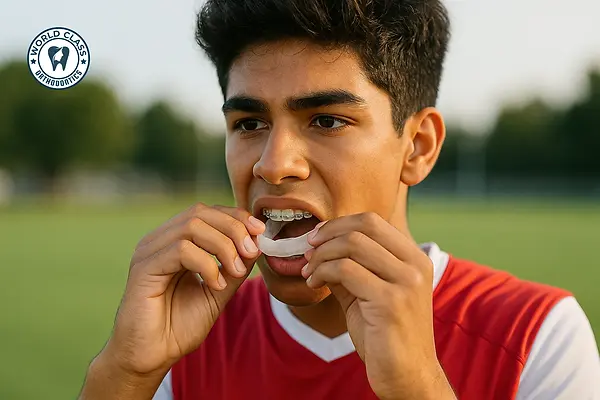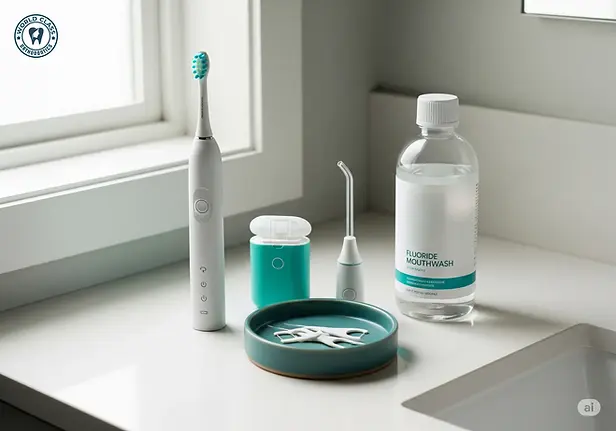Teen Orthodontics — Dubai & Sharjah

Facially driven orthodontic treatment for teens that fits school, sport and real life. Our specialist orthodontist plans care around growth so teenagers can straighten teeth, protect long‑term oral health, and build self-esteem—without missing what matters in the teen years. We create a personalized treatment plan for every family, aiming for stable function and a beautiful smile.
Orthodontic treatments are available for patients of all ages, including children, teenagers, and adults, ensuring care is tailored to the unique needs of every age group.
Why families choose us:
-
Teen‑first orthodontic care (≈80% of cases are teens)
-
Since 2010 • 2,000+ cases, complex cases welcome
-
Traditional metal braces, ceramic braces, clear braces, Invisalign aligners when suitable
-
Growth guidance with timing‑based appliances for young patients
-
After‑school & weekend visits • free consultation • 0% EMI

Is my teen ready for orthodontic treatment?
Parents often notice alignment issues, misaligned teeth, protruding teeth, spacing problems, or jaw concerns as permanent teeth replace baby teeth. If your child’s teeth look crowded, if upper and lower teeth don’t meet well, or if speech/chewing is affected, book an initial consultation. An experienced orthodontist will check children and teens carefully and outline a staged treatment plan.
Precise diagnosis (Deira, Al Rigga): clinical photos, 3D scan and—when clinically indicated—low‑dose panoramic OPG and lateral ceph. We follow ALARA; if you have recent films for your child’s dental health/child’s oral health, we can use them.
Treatment options: braces and aligners for teenagers
Traditional braces for teens
Traditional braces remain a gold standard in orthodontic treatment for teens. We use traditional metal braces for durability and efficiency, and ceramic braces or clear braces for a discreet look. Metal braces work predictably on many bite issues and complex tooth movements. Our orthodontist plans gentle, necessary adjustments that fit school timetables, with clear advice on foods and comfort.
Damon braces and self‑ligating options
Some stages are managed with self‑ligating systems such as Damon braces when appropriate. Your orthodontist will explain where these fit within the overall treatment plan for optimal results.
Invisalign aligners for motivated teens
Invisalign aligners are a type of clear aligner—a discreet, removable alternative to traditional braces, suitable for teens and even younger kids. They can be custom made and specifically designed for teens who can wear trays 20–22 hours/day. Expect small tooth‑colored attachments, occasional IPR (polishing between teeth), elastics, refinements and clear guidance so expected results match goals. Because clear aligners are nearly invisible, they can help teens and kids who might feel self conscious about wearing braces. We also provide advice for kids teeth during mixed dentition where aligners are considered, including Invisalign First, which is specifically designed for the unique dental needs of a kid, providing a comfortable and effective early intervention option.

We’ll recommend the option—braces or invisalign—that moves teeth most predictably for your teenager’s goals and oral health.
Early intervention vs comprehensive care
Early orthodontic treatment (also called interceptive care) can help some children at an early age, especially where kids’ teeth show crowding, crossbites or airway concerns. Phase‑one orthodontic treatment aims to simplify later treatment in the teen years. Many children don’t need early appliances; we monitor growth and schedule regular check ups so your orthodontist can time comprehensive treatment when permanent teeth are ready.
We provide clear advice for children and teens so you know the best age to start and how the treatment plan will progress.
Guiding jaw growth (timed appliances)
When timing is right, we guide the growth and development of jaws to support function and facial balance. Your orthodontist may use gentle, timing‑based appliances (for example a twin‑block, Herbst or palatal expander) to help upper and lower teeth meet well. These tools are combined with braces or invisalign aligners when they improve predictability for children and teens. We discuss benefits, risks and home care in plain language suitable for kids and parents.
Note: we keep the phrase “functional appliances” to clinical conversations, explaining what each device does and how it supports orthodontic treatment.
Braces vs aligners: which is better for my teen?

-
Predictability: Larger rotations/vertical changes often respond faster with braces; invisalign works well in motivated teens.
-
Lifestyle: Removable aligners come out for eating and photos; braces need food care.
-
Comfort: Both cause short‑term pressure; wax helps with braces; aligner tenderness settles in 24–48 hours.
-
Aesthetics: Ceramic braces are discreet; invisalign aligners are less visible but not invisible where attachments/elastics are used.
Your orthodontist will tailor the treatment plan, so parents of children and teens understand trade‑offs and likely timelines.
School, sport, instruments & favorite foods
We plan orthodontic treatment around real life—after‑school and weekend visits, exam‑time spacing, and safe sport. We’ll advise a braces‑compatible mouthguard and comfort tips for brass/woodwind. We also show kids and teens how to enjoy favorite foods safely during treatment.
Hygiene & gum health during treatment
Good hygiene prevents white‑spot marks and protects gums from gum disease. We coach children and teens to brush after meals, floss with threaders or a water flosser, and use fluoride mouthwash. We also schedule regular check ups and progress checks with your orthodontist so small dental issues don’t become big ones.
Common concerns we treat in children and teens
-
Overjet/protruding teeth and deep over‑closure (managed with braces or invisalign aligners plus elastics)
-
Crossbites and narrow arches (expansion, then braces)
-
Open vertical relationships (planned vertical control)
-
Crowding and alignment issues (space creation, selective IPR or extraction if best for facial balance)
-
Localised problems affecting the lower teeth or single segments
Our experienced orthodontists agree that clear goals, staged treatment, and home care deliver predictable outcomes for children and teens.
What to expect: from initial consultation to retention
-
Initial consultation — your orthodontist examines children and teens, records photos/scan, and explains options.
-
Customized treatment plan — we map stages for braces or invisalign, outline timelines and costs for orthodontic treatment, and share how we’ll straighten teeth.
-
Active treatment — school‑friendly visits with necessary adjustments; we keep treatment efficient and comfortable.
-
Finishing — detailed control for a stable, perfect smile and healthy function.
-
Retention — fixed wires and/or removable retainers with clear wear‑time to protect results in children and teens.
Braces for kids vs teen braces (what parents ask)
Many parents search for braces for kids or kids braces when they really need advice for teens. We provide pediatric orthodontics (interceptive) for children who benefit from early intervention, then continue with braces for kids or teen braces when age and growth are right. If you’re comparing braces for kids with teen care, our orthodontist will explain timing, appliances and the safest path for your child’s teeth and child’s oral health.
People also search “best orthodontist” in Dubai; we recommend choosing a specialist orthodontist with strong diagnostics, a clear treatment plan, transparent fees and time for questions.
Costs, access and booking
We keep fees transparent and provide 0% EMI. Check Orthodontic Treatment Cost for typical ranges and ask about invisalign packages. Book a free consultation at our Deira clinic to discuss orthodontic treatment options for children and teens.
Call / WhatsApp / Directions — our team will help you schedule regular check ups and plan orthodontic treatment that respects school calendars.



Risks & limitations:
-
Mild tenderness after adjustments
-
Aligner success depends on 20–22 hrs/day wear.
-
Some movements (large rotations/vertical changes) are faster with braces.
-
Attachments may cause some discomfort or irritation.
We discuss alternatives, timelines and retention so you can choose confidently.
FAQs
What’s the best age to start?
Most children should see an orthodontist by 7–8 to screen for early needs; comprehensive orthodontic treatment often starts in the teen years when permanent teeth are in. Your orthodontist will advise the best age and timing.
Are braces or Invisalign aligners better for teenagers?
Both can work. Traditional braces handle tough movements efficiently; Invisalign aligners suit motivated teens who wear trays 20–22 hours/day. Your orthodontist will match goals to the treatment plan.
How long does treatment take?
Typical teen treatment is 12–24 months, depending on goals, growth and appliance care. Good hygiene and attendance help treatment stay on schedule.
Are X‑rays safe for my child?
Yes—used only when indicated and kept low dose. Safety is our top priority and part of protecting children and kids teeth for life.
Can my child play sport and instruments with braces?
Yes. We fit mouthguards and share comfort tips. With proper care, most children adapt quickly and keep up with activities during treatment.
Do you treat complex cases?
Yes—complex cases are welcome. An experienced orthodontist will map a staged treatment plan with optimal results as the goal.
Clinically reviewed by
Dr. Srinivasa Rao Bogavilli, MDS (Orthodontics) — Specialist orthodontist
Teen and children care since 2010; 2,000+ cases; facially driven planning.
Medical information is general; please book an initial consultation for a personalized assessment.